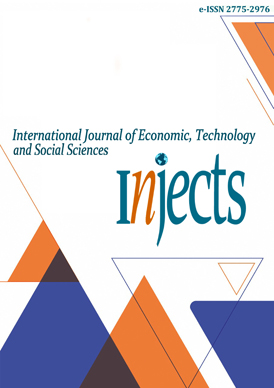ANALYSIS OF COMMERCIAL CUSTOMER SATISFACTION LEVEL IN PT PERUSAHAAN GAS NEGARA (PERSERO) TBK SBU DISTRIBUSI WILAYAH III SUMATERA BAGIAN UTARA
DOI:
https://doi.org/10.53695/injects.v2i2.541Keywords:
Commercial Customer Satisfaction Level, ServqualAbstract
This study examined of Commercial Customer Satisfaction Level In PT Perussahaan Gas Negara (Persero) Tbk, SBU Distribusi Wilayah III Sumatera Bagian Utara. . The study used descriptive statistical analysis using cartesian diagram which divided into four parts bounded by two lines that intersect perpendicularly at points X and Y. This diagram is also called the importance-performance matrix is used to describe the priority dimension of service quality. or service attributes that need to be improved and serve as a guide for formulating improvement strategies based on decrease in the number of customers in the commercial customer segment from 579 customers in 2012 to 540 customers in 2017, while customers in other segments, namely industry and households increased. The population in this study is all commercial customers in the State Gas Company (Persero) Tbk SBU Distribusi Region III in Medan City as many as 540 commercial customers during the period of 2018. Sampling technique in this study by using probability sampling method with simple random sampling technique. From the results of the research and discussion described in the previous chapter, it is concluded that based on the Descriptive Analysis and Cartesian Diagram Analysis that the influence of service quality consists of: tangible (direct evidence), reliability (reliability), responsiveness (responsiveness), assurance (guarantee). ), and empathy for the level of satisfaction of commercial customers at PT. Perusahaan Gas Negara (Persero) SBU Distribusi Wilayah III Sumatera Bagian Utara is categorized as sufficient. From the five dimensions of service quality, the most dominant variable inservice improvement is the tangible variable (direct evidence).References
Parasuraman, A., Berry, L., & Zeithaml, V. (2002). Refinement and reassessment of the Servqual scale. Journal of retailing, 67(4), 114.
Raspor, S. (2010). Measuring perceived service quality using SERVQUAL: a case study of the Croatian hotel industry. Management (18544223), 5(3).
Haming, M., Murdifin, I., Syaiful, A. Z., & Putra, A. H. P. K. (2019). The application of Servqual distribution in measuring customer satisfaction of retails company. The Journal of Distribution Science, 17(2), 25-34.
Atmowardoyo, H. (2018). Research methods in TEFL studies: Descriptive research, case study, error analysis, and R & D. Journal of Language Teaching and Research, 9(1), 197-204.
Sekaran, U., & Bougie, R. (2019). Research methods for business: A skill building approach. john wiley & sons.
Gruber, T. (2011). I want to believe they really care: How complaining customers want to be treated by frontline employees. Journal of service management.




